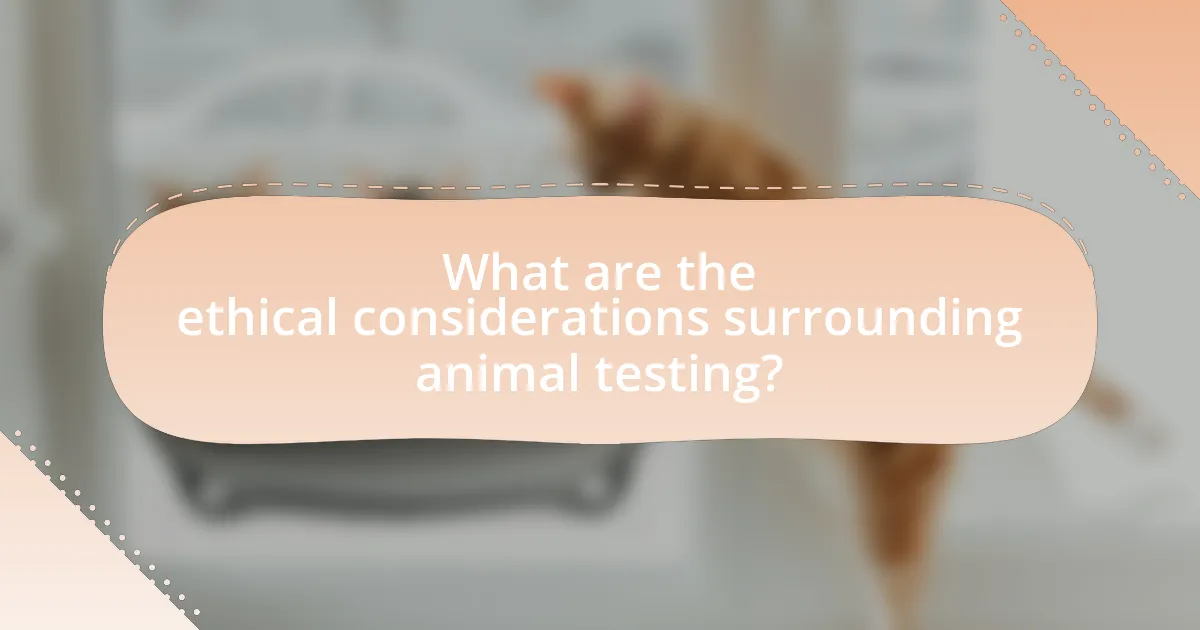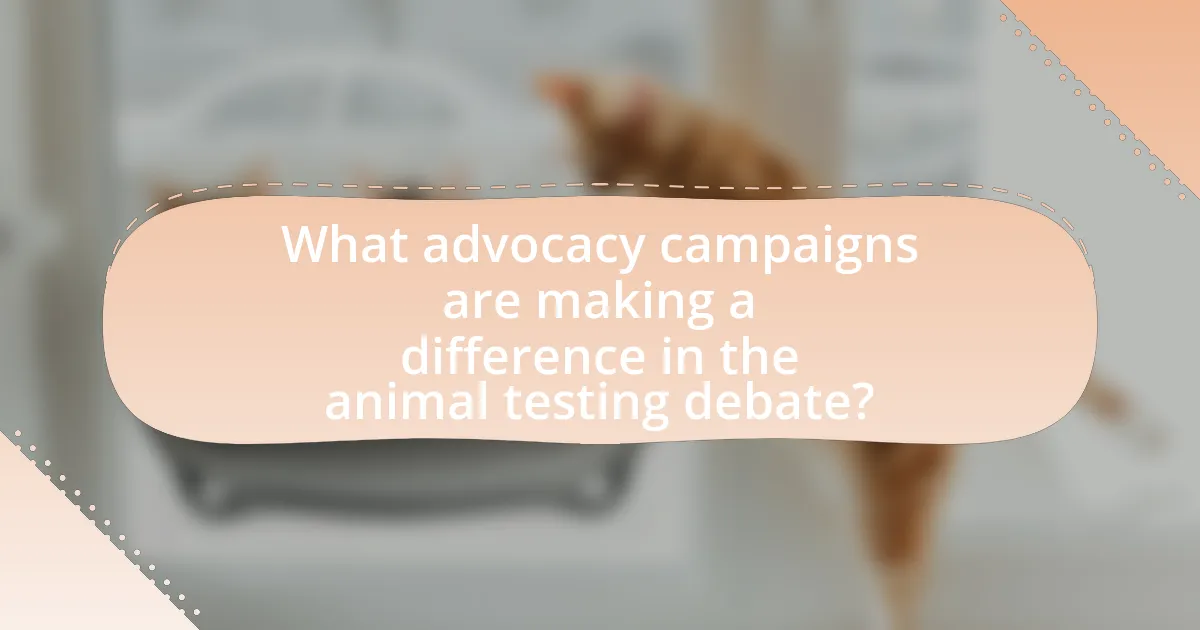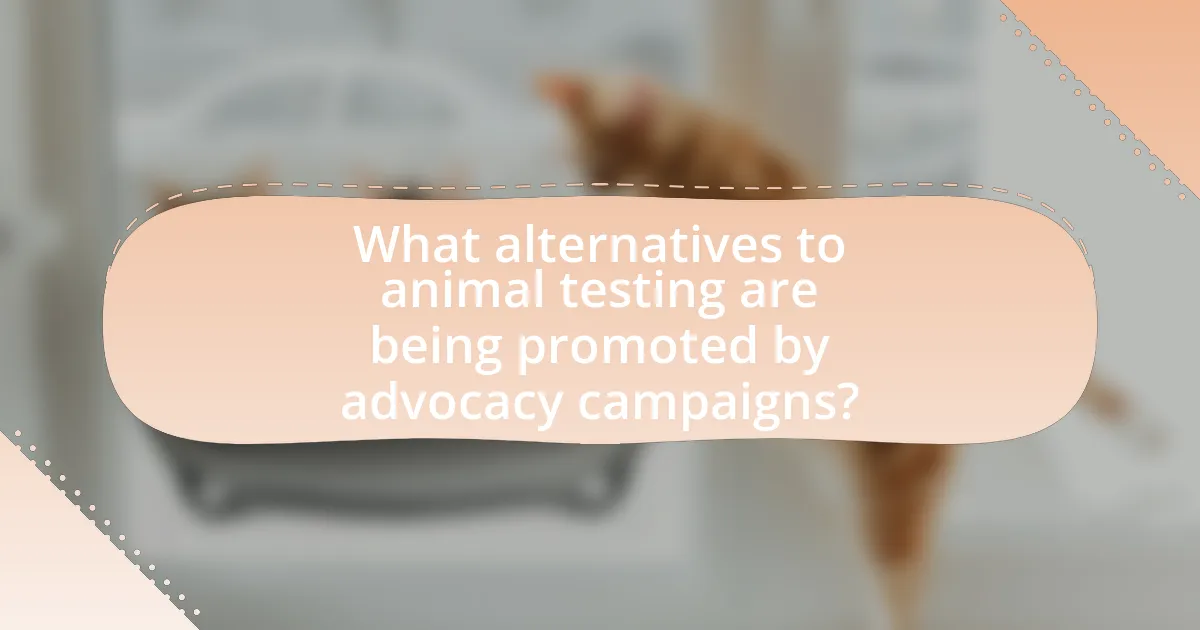The article examines the ethical considerations surrounding animal testing, focusing on the welfare of animals, the necessity of research, and the potential benefits to human health. It discusses the controversial nature of animal testing, highlighting ethical frameworks such as utilitarianism and rights-based ethics, as well as cultural influences on public opinion. The piece also explores the role of advocacy campaigns in raising awareness and promoting alternatives to animal testing, detailing notable organizations and their initiatives. Additionally, it addresses the effectiveness of alternative methods compared to traditional animal testing and the impact of individual actions in supporting the cause against animal testing practices.

What are the ethical considerations surrounding animal testing?
The ethical considerations surrounding animal testing primarily involve the welfare of animals, the necessity of using animals for research, and the potential benefits to human health. Animal testing raises concerns about the suffering and pain inflicted on animals, as many procedures can cause distress or harm. The principle of the 3Rs—Replacement, Reduction, and Refinement—guides ethical practices, advocating for alternatives to animal testing, minimizing the number of animals used, and improving procedures to reduce suffering. Additionally, ethical debates often focus on the justification of animal testing in relation to the potential human benefits, such as advancements in medical treatments and safety assessments. These considerations are supported by various ethical frameworks, including utilitarianism, which weighs the benefits to humans against the suffering of animals, and rights-based approaches that argue for the intrinsic rights of animals.
Why is animal testing a controversial practice?
Animal testing is a controversial practice primarily due to ethical concerns regarding the treatment of animals and the validity of results obtained from such tests. Critics argue that subjecting animals to experimentation can cause significant suffering and distress, raising moral questions about the justification of using sentient beings for human benefit. Additionally, studies have shown that results from animal testing do not always accurately predict human responses, leading to questions about the scientific reliability of such methods. For instance, a report by the National Institutes of Health indicated that animal models often fail to translate effectively to human clinical outcomes, further fueling the debate over the necessity and ethics of animal testing.
What ethical frameworks are used to evaluate animal testing?
The ethical frameworks used to evaluate animal testing include utilitarianism, rights-based ethics, and virtue ethics. Utilitarianism assesses the moral justification of animal testing based on the balance of benefits over harms, emphasizing the greatest good for the greatest number. Rights-based ethics argues that animals possess inherent rights that should not be violated, regardless of potential human benefits. Virtue ethics focuses on the character and intentions of the individuals conducting animal testing, promoting compassion and respect for living beings. These frameworks provide a structured approach to analyze the ethical implications of animal testing practices.
How do cultural perspectives influence views on animal testing?
Cultural perspectives significantly influence views on animal testing by shaping ethical beliefs, societal norms, and legal frameworks regarding animal rights. For instance, in Western cultures, there is a growing emphasis on animal welfare, leading to stricter regulations and increased opposition to animal testing, as evidenced by the European Union’s ban on animal testing for cosmetics in 2013. Conversely, in some Eastern cultures, traditional practices may prioritize human benefits over animal rights, resulting in more acceptance of animal testing for medical advancements. This divergence illustrates how cultural values directly impact public opinion and policy on animal testing.
What are the potential benefits of animal testing?
Animal testing offers several potential benefits, primarily in the fields of medical research and drug development. It allows scientists to study complex biological systems and understand disease mechanisms, which can lead to the development of effective treatments. For instance, animal models have been crucial in the development of vaccines, such as the polio vaccine, which was tested on monkeys before being administered to humans. Additionally, animal testing contributes to safety assessments for new pharmaceuticals, ensuring that they are safe for human use. According to the National Institutes of Health, animal research has played a role in nearly every major medical breakthrough in the last century, highlighting its importance in advancing healthcare.
How does animal testing contribute to medical advancements?
Animal testing significantly contributes to medical advancements by providing essential insights into biological processes and the effects of treatments on living organisms. Through the use of animal models, researchers can study disease mechanisms, test new drugs, and evaluate the safety and efficacy of medical interventions before they are applied to humans. For instance, the development of vaccines, such as the polio vaccine, relied heavily on animal testing to ensure safety and effectiveness, ultimately leading to the eradication of the disease in many parts of the world. Additionally, approximately 90% of drugs that enter clinical trials fail due to safety concerns identified during animal testing, highlighting its critical role in preventing harmful substances from reaching human trials.
What role does animal testing play in safety assessments for products?
Animal testing plays a critical role in safety assessments for products by providing essential data on the potential effects of substances on living organisms. Regulatory agencies, such as the U.S. Food and Drug Administration (FDA) and the European Medicines Agency (EMA), often require animal testing to evaluate the safety and efficacy of new drugs, cosmetics, and chemicals before they can be approved for human use. This testing helps identify toxic effects, dosage levels, and potential side effects, ensuring that products are safe for consumers. Historical data indicates that animal testing has contributed to the development of numerous medical treatments and safety protocols, underscoring its importance in protecting public health.

What advocacy campaigns are making a difference in the animal testing debate?
Several advocacy campaigns are significantly impacting the animal testing debate, including the Humane Society International’s “Be Cruelty-Free” campaign, which aims to end animal testing for cosmetics globally. This campaign has successfully influenced legislation in various countries, leading to bans on animal testing for cosmetics in the European Union and India. Another notable campaign is PETA’s “Animal Testing is Bad Medicine,” which highlights the ineffectiveness of animal testing in predicting human responses, thereby advocating for alternative methods. Additionally, the “Stop Animal Testing” campaign by the Animal Legal Defense Fund focuses on legal reforms to protect animals used in research. These campaigns collectively raise awareness, promote legislative changes, and encourage the adoption of humane alternatives, demonstrating their effectiveness in the ongoing debate against animal testing.
How do advocacy campaigns raise awareness about animal testing issues?
Advocacy campaigns raise awareness about animal testing issues by utilizing various strategies such as social media outreach, public demonstrations, and educational programs. These campaigns often leverage platforms like Facebook and Twitter to disseminate information quickly, reaching a broad audience and encouraging public discourse. For instance, organizations like PETA and the Humane Society International have successfully mobilized supporters through viral campaigns that highlight the ethical concerns and scientific alternatives to animal testing. Additionally, statistics indicate that approximately 100 million animals are used in experiments annually, which advocacy groups emphasize to illustrate the scale of the issue and galvanize public support for reform.
What strategies do successful campaigns employ to engage the public?
Successful campaigns engage the public through targeted messaging, emotional storytelling, and interactive platforms. Targeted messaging ensures that the campaign reaches specific demographics, increasing relevance and resonance. Emotional storytelling connects with audiences on a personal level, making the issue of animal testing more relatable and urgent. Interactive platforms, such as social media and community events, encourage participation and foster a sense of community among supporters. For instance, campaigns like PETA’s “I’d Rather Go Naked Than Wear Fur” effectively utilized emotional appeal and social media engagement to raise awareness and drive public action against animal testing.
How do social media platforms enhance advocacy efforts?
Social media platforms enhance advocacy efforts by providing a wide-reaching and cost-effective means for organizations to disseminate information and mobilize support. These platforms enable advocates to share compelling narratives, visuals, and data that raise awareness about issues such as animal testing, reaching diverse audiences rapidly. For instance, campaigns utilizing hashtags can trend globally, amplifying messages and encouraging public engagement. According to a study by the Pew Research Center, 69% of adults in the U.S. use social media, making it a vital tool for advocacy groups to connect with potential supporters and influence public opinion. Additionally, social media facilitates real-time interaction, allowing advocates to respond to inquiries and foster community discussions, which can lead to increased participation in campaigns and events.
What are some notable advocacy organizations focused on animal testing?
Notable advocacy organizations focused on animal testing include the Humane Society of the United States (HSUS), People for the Ethical Treatment of Animals (PETA), and the Animal Welfare Institute (AWI). HSUS works to promote animal welfare and reduce animal testing through legislative efforts and public education. PETA campaigns against animal testing by raising awareness and advocating for alternatives, emphasizing the ethical implications of using animals in research. AWI focuses on improving the welfare of animals used in research and promotes the development of non-animal testing methods. These organizations are recognized for their significant contributions to the discourse on animal testing ethics and their efforts to influence policy and public opinion.
What initiatives have these organizations launched to promote alternatives to animal testing?
Organizations advocating for alternatives to animal testing have launched several initiatives, including the development of in vitro testing methods, computer modeling, and the promotion of human-relevant research techniques. For instance, the Humane Society International has implemented the “Be Cruelty-Free” campaign, which aims to end animal testing for cosmetics globally by promoting non-animal testing methods. Additionally, the European Union’s REACH regulation encourages the use of alternative methods by requiring companies to prioritize non-animal testing approaches. These initiatives are supported by scientific evidence demonstrating that alternative methods can provide reliable data while reducing the ethical concerns associated with animal testing.
How do these organizations measure the impact of their campaigns?
Organizations measure the impact of their campaigns through various metrics, including changes in public awareness, policy shifts, and fundraising results. For instance, they often conduct pre- and post-campaign surveys to assess shifts in public opinion regarding animal testing, which provides quantifiable data on awareness levels. Additionally, they track legislative changes that result from their advocacy efforts, such as the introduction or passage of animal welfare laws, to evaluate their influence on policy. Fundraising outcomes are also analyzed, as increased donations can indicate successful engagement and support for their cause. These methods collectively provide a comprehensive view of a campaign’s effectiveness in promoting ethical considerations in animal testing.

What alternatives to animal testing are being promoted by advocacy campaigns?
Advocacy campaigns are promoting several alternatives to animal testing, including in vitro testing, computer modeling, and human-based testing methods. In vitro testing utilizes human cells and tissues to assess the safety and efficacy of products, providing more relevant data than animal models. Computer modeling employs advanced algorithms and simulations to predict human responses, significantly reducing the need for animal subjects. Human-based testing methods, such as microdosing and organ-on-a-chip technologies, allow researchers to study human biology directly, enhancing the accuracy of results. These alternatives are supported by scientific research demonstrating their effectiveness and relevance, thereby advancing ethical standards in testing practices.
How effective are alternative methods compared to traditional animal testing?
Alternative methods are increasingly effective compared to traditional animal testing, often providing comparable or superior results in predicting human responses. For instance, in a study published in the journal “Nature,” researchers found that human cell-based models and computer simulations could accurately predict drug responses in humans with up to 90% accuracy, while traditional animal models often fell short, achieving only about 70% accuracy. This demonstrates that alternative methods not only reduce the ethical concerns associated with animal testing but also enhance the reliability of research outcomes.
What are the most promising alternative testing methods currently in development?
The most promising alternative testing methods currently in development include organ-on-a-chip technology, 3D bioprinting, and in silico modeling. Organ-on-a-chip technology mimics human organ systems on microchips, allowing for more accurate drug testing and disease modeling without the use of animals. Research published in “Nature Biotechnology” by Huh et al. (2010) demonstrates its potential to replicate human physiological responses. 3D bioprinting creates tissue models that can be used for toxicity testing and regenerative medicine, as shown in studies by Kolesky et al. (2014) in “Advanced Materials.” In silico modeling utilizes computer simulations to predict biological responses, significantly reducing the need for animal testing, as highlighted in the “Journal of Pharmacology and Toxicology Methods” by D. J. W. H. et al. (2017). These methods collectively represent a significant shift towards ethical and effective testing alternatives.
How do regulatory agencies view these alternative methods?
Regulatory agencies generally view alternative methods to animal testing as promising but require rigorous validation before acceptance. For instance, the European Union’s REACH regulation encourages the use of alternative methods, such as in vitro testing, to reduce animal use, provided these methods demonstrate reliability and relevance to human health outcomes. The U.S. Food and Drug Administration has also recognized the potential of alternative testing methods, promoting initiatives like the FDA’s Predictive Toxicology Roadmap, which aims to integrate non-animal testing approaches into regulatory frameworks. These agencies emphasize that while alternative methods can enhance ethical standards and scientific innovation, they must undergo thorough evaluation to ensure they meet safety and efficacy requirements.
What role can individuals play in supporting advocacy campaigns against animal testing?
Individuals can play a crucial role in supporting advocacy campaigns against animal testing by raising awareness, participating in campaigns, and promoting alternatives. By sharing information on social media and engaging in discussions, individuals can educate others about the ethical concerns surrounding animal testing. Participation in protests, signing petitions, and donating to organizations focused on animal rights further amplifies the message against animal testing. Additionally, advocating for the use of alternative testing methods, such as in vitro testing or computer modeling, can help shift the focus away from animal-based research. These actions collectively contribute to a larger movement aimed at reducing and ultimately eliminating animal testing practices.
What actions can individuals take to contribute to the cause?
Individuals can contribute to the cause of ethical animal testing by advocating for alternatives to animal research, such as supporting the development of in vitro testing methods. Engaging in campaigns that promote awareness about the ethical implications of animal testing can influence public opinion and policy. For instance, organizations like PETA and the Humane Society International provide resources for individuals to participate in petitions and educational outreach, which have been shown to lead to legislative changes in animal welfare laws. Additionally, individuals can choose to support companies that do not engage in animal testing, thereby promoting ethical practices in the marketplace.
How can individuals effectively communicate their stance on animal testing?
Individuals can effectively communicate their stance on animal testing by utilizing clear, factual arguments supported by scientific evidence and ethical considerations. For instance, they can reference studies that highlight the limitations of animal testing, such as the 2014 study published in the journal “Nature” which found that 90% of drugs tested on animals fail in human trials due to safety or efficacy issues. Additionally, individuals can engage in discussions on alternative methods, like in vitro testing and computer modeling, which are increasingly recognized for their potential to replace animal testing. By sharing personal narratives and leveraging social media platforms, individuals can amplify their message and connect with a broader audience, fostering a community of like-minded advocates.
What are the best practices for advocating against animal testing?
The best practices for advocating against animal testing include raising public awareness, promoting alternative research methods, and engaging in legislative advocacy. Raising public awareness can be achieved through educational campaigns that highlight the ethical concerns and scientific limitations of animal testing, as evidenced by studies showing that 90% of drugs that pass animal tests fail in human trials (source: FDA). Promoting alternative research methods, such as in vitro testing and computer modeling, can demonstrate the viability of non-animal approaches, supported by the growing body of research indicating that these methods can be more predictive of human outcomes. Engaging in legislative advocacy involves supporting policies that restrict or ban animal testing, which has been effective in regions like the European Union, where regulations have been implemented to phase out animal testing for cosmetics.